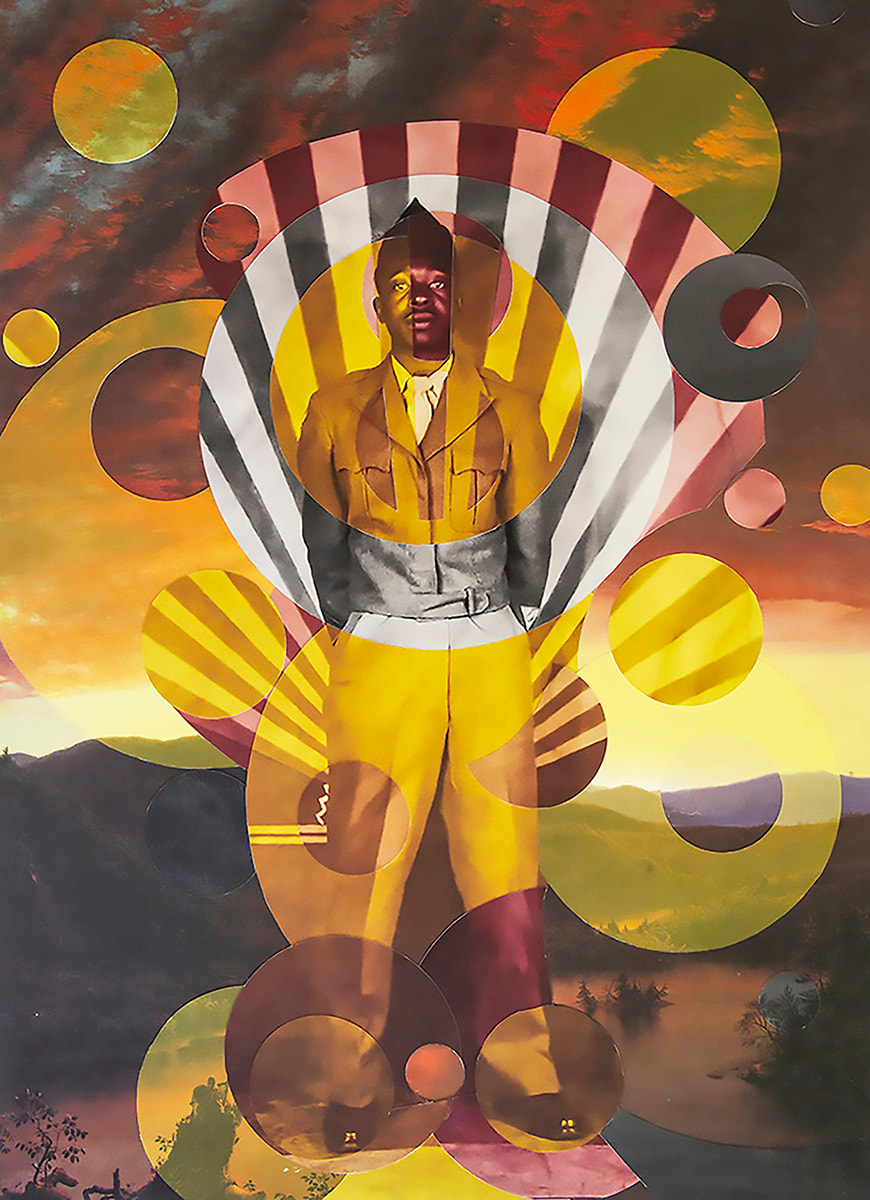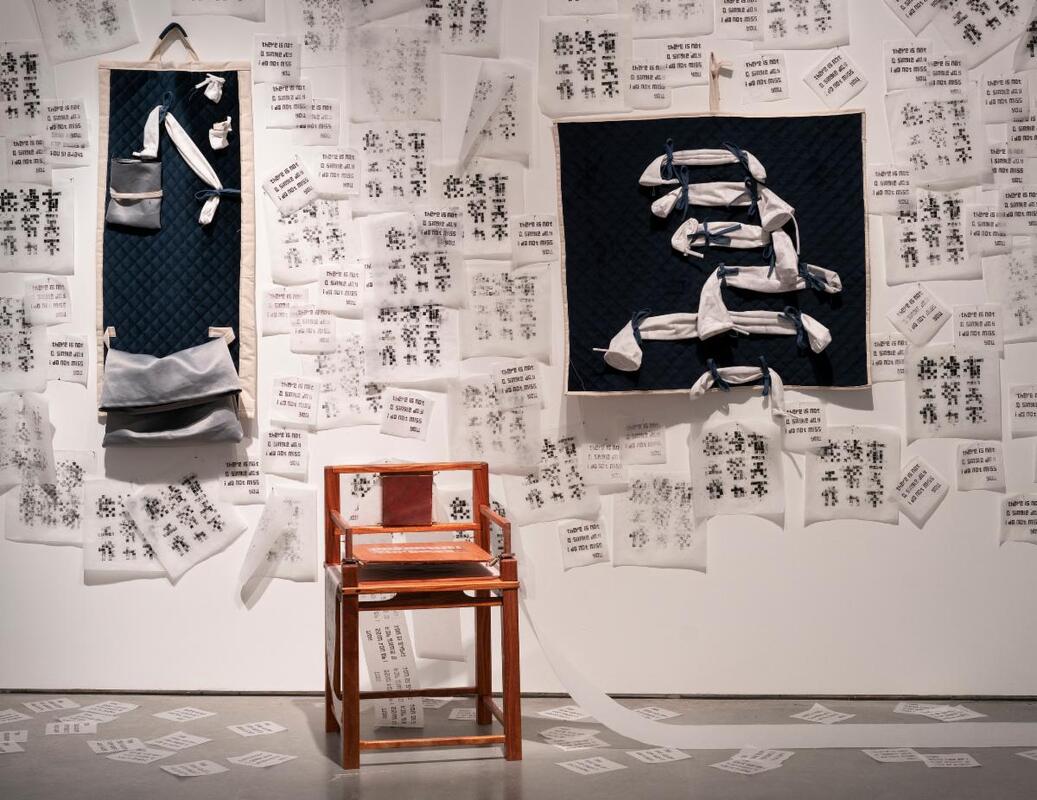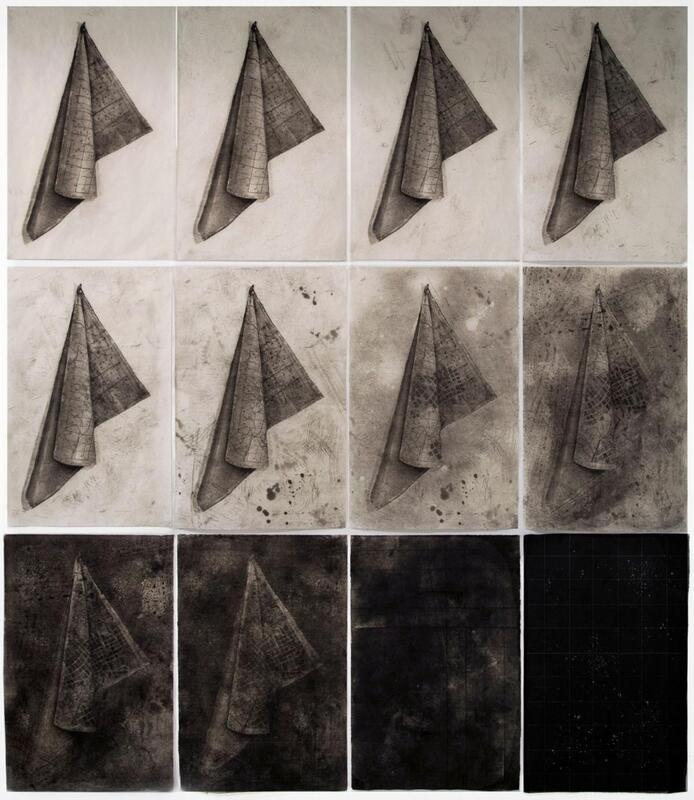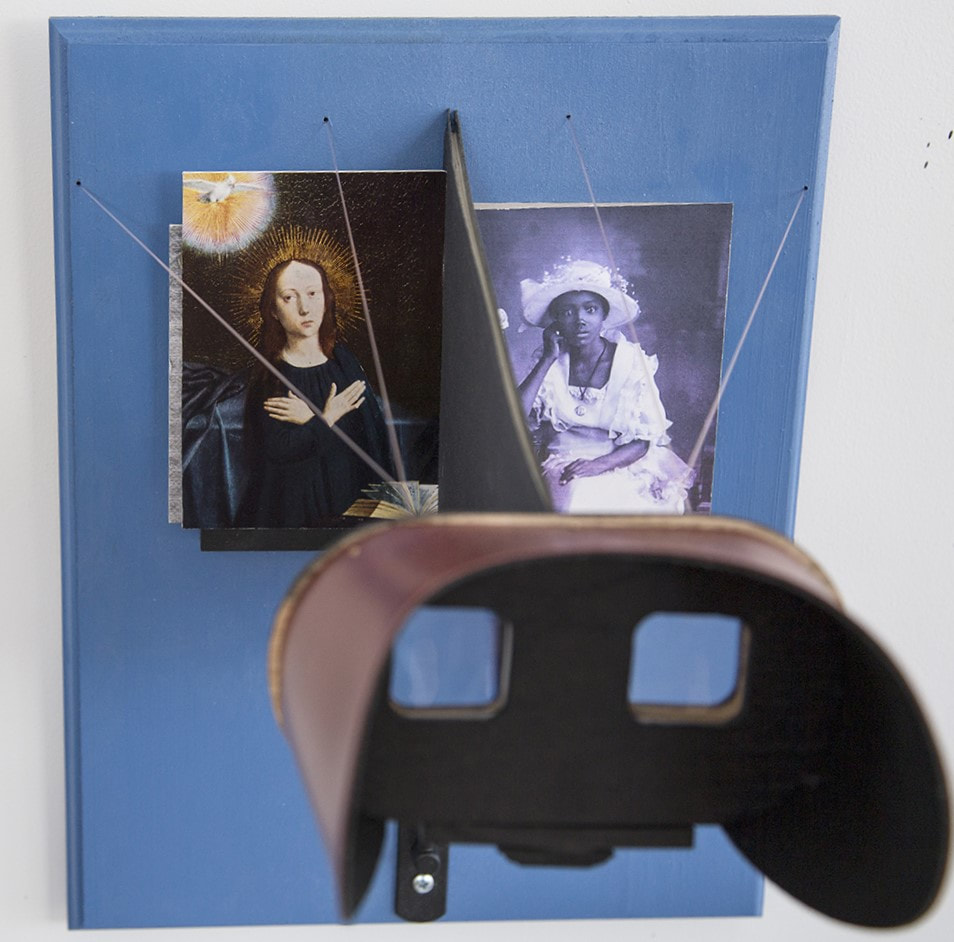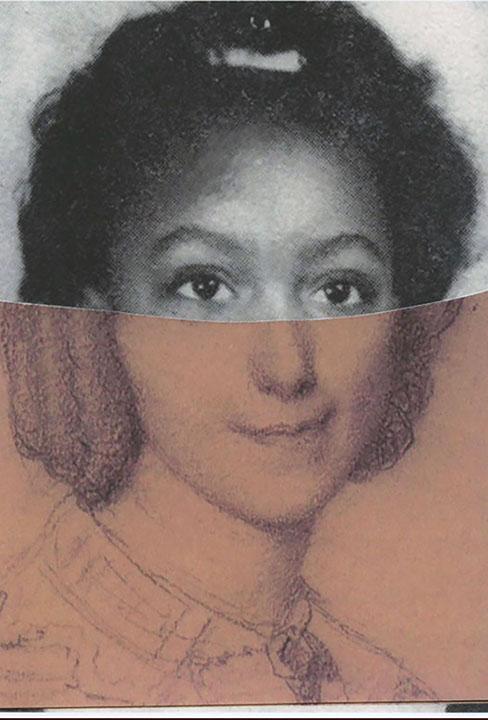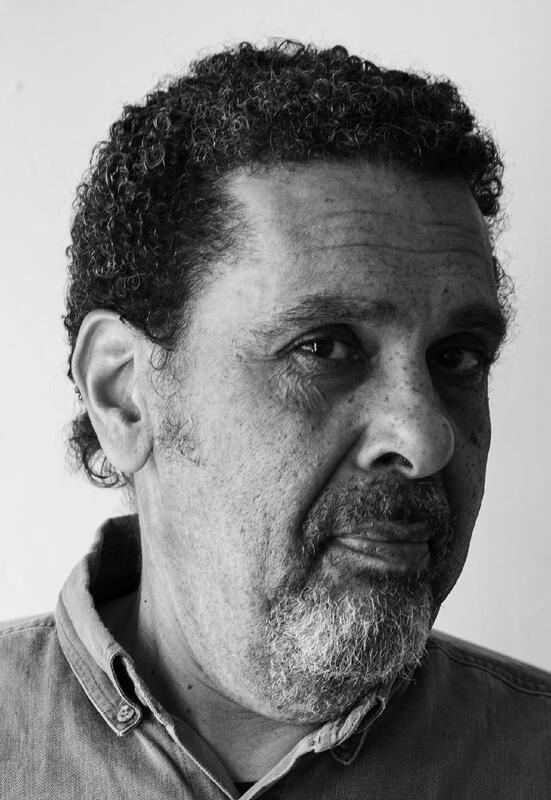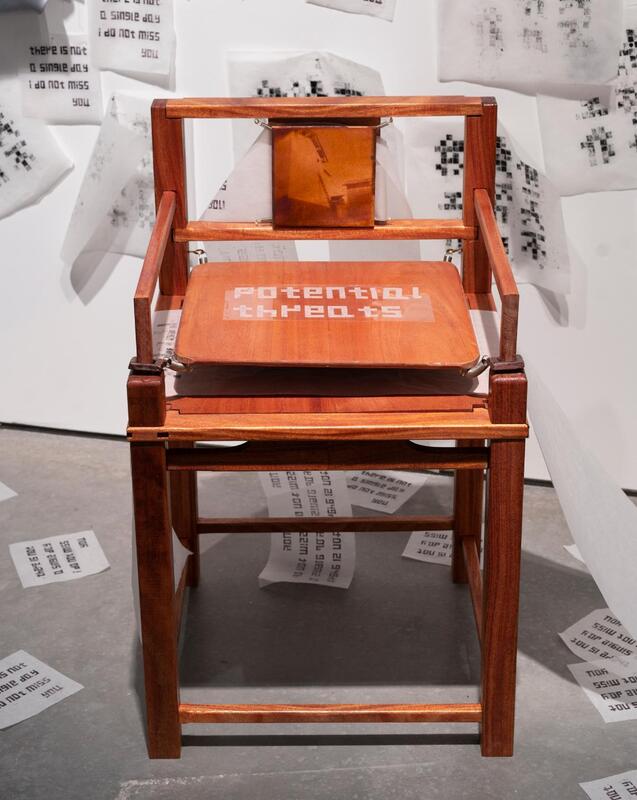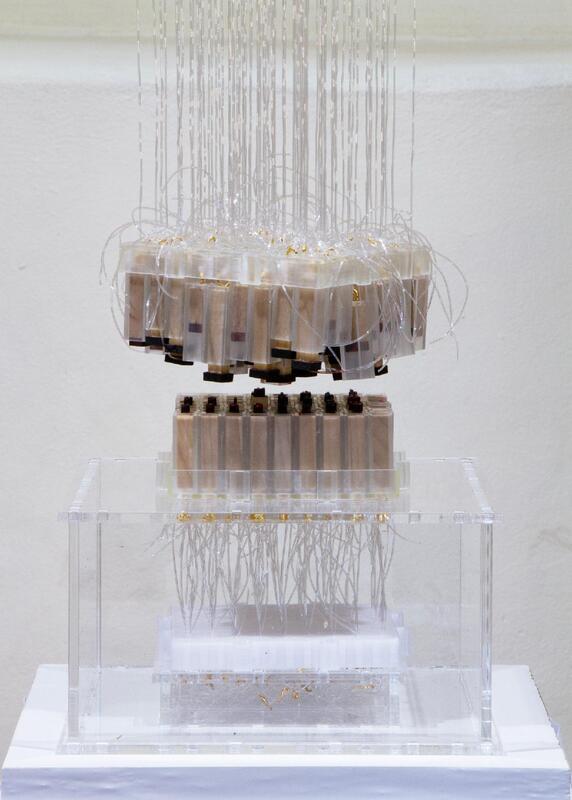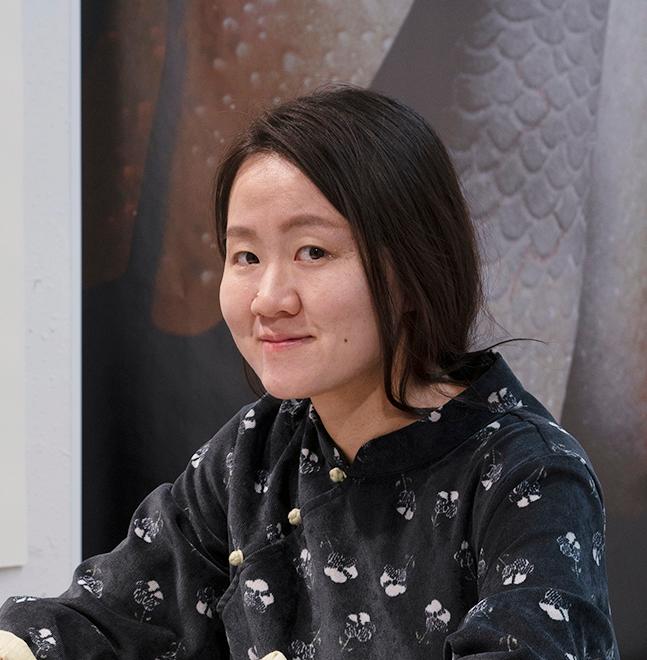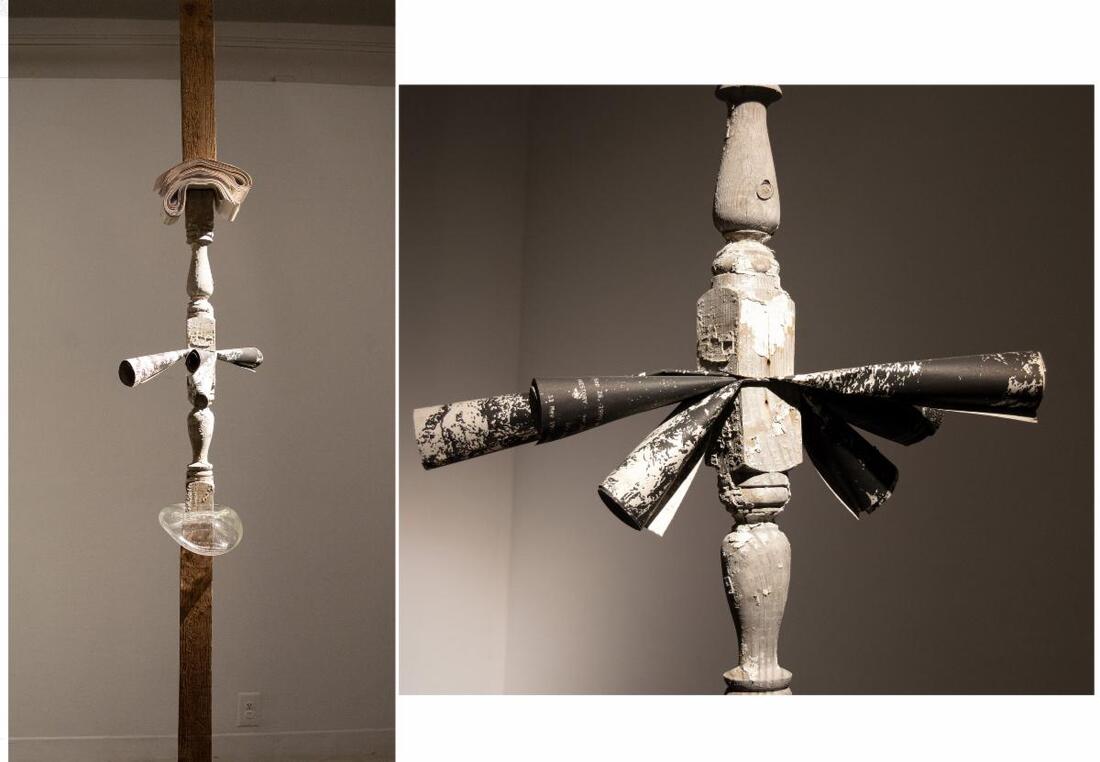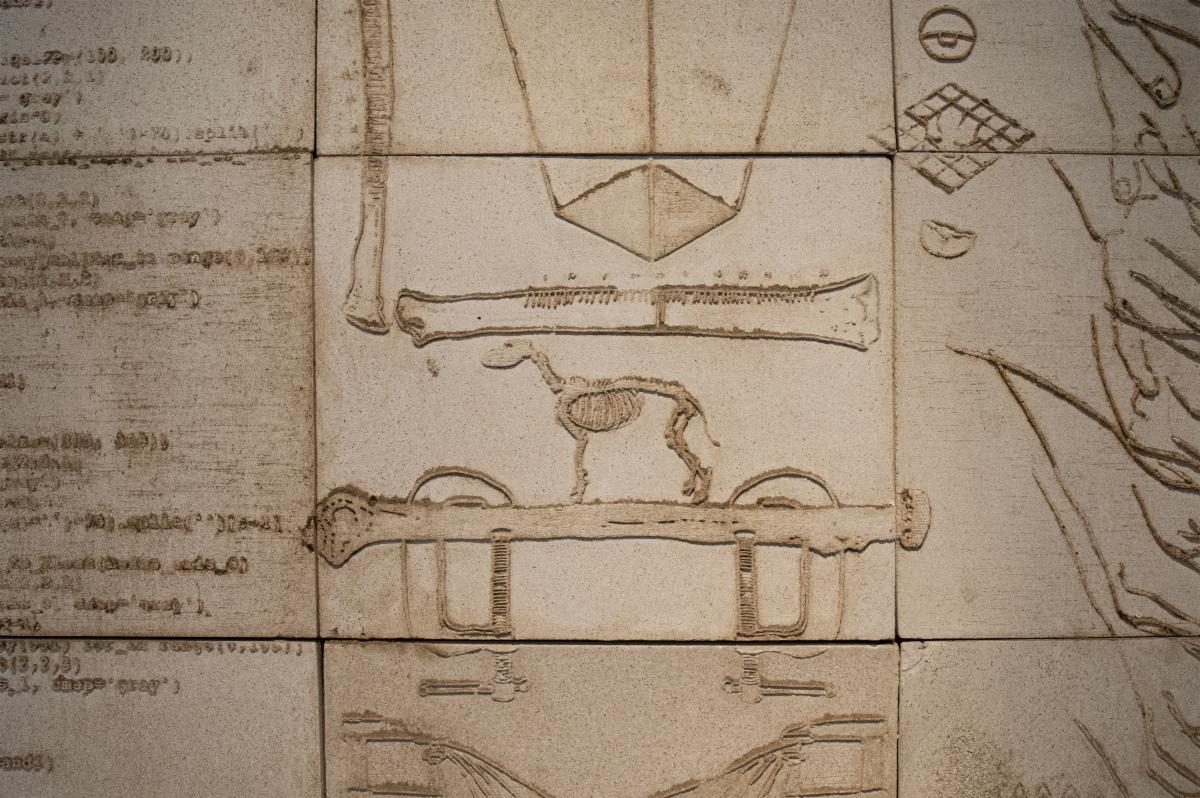|
|
|
The Print Center Announces the 98th ANNUAL International Competition Solo Exhibitions
Gary Burnley: Caste
Ranran Fan: Pressing Matters 按压即可
and
Natalia Mejía Murillo: Between Emergency and Imminence
in the Zemel Family Gallery
January 19 – March 30, 2024
(left to right) Gary Burnley, Twilight 2, 2022, collage; Ranran Fan, 我没有一天不努力工作,我没有一天不想念你 There is not a single day I don't work hard; there is not a single day I don't miss you, 2021, multi-media installation; Natalia Mejía Murillo, White Lies, 2021, etching, aquatint and drypoint on Gampi
PHILADELPHIA, PA – The Print Center is pleased to present three new solo exhibitions of recent work by Gary Burnley (born St. Louis, MO, lives Ridgefield, CT), Ranran Fan (born China, lives Denton, TX), and Natalia Mejía Murillo (born Colombia, lives Doha, Qatar), opening on January 19, 2024. The artists were awarded these exhibitions from the nearly 500 applicants to the 98th ANNUAL International Competition.
I am so pleased to have been invited to organize the ANNUAL solo exhibitions for a second year. Chosen from the juror’s selection of ten Finalists, these three exhibitions present artworks created using a wide range of techniques, from relief printing with eggshells, to furniture as printing press, to photo collage. Although visually quite different, the work of Gary Burnley, Ranran Fan and Natalia Mejía Murillo comprises personal quests for meaning within media, history and family, while leveraging the potential of print to reference communication across space and time.
– Liz K. Sheehan, Guest Curator
Gary Burnley: Caste
In Gary Burnley’s (he/his) collages, reproductions of historic portrait paintings are layered with black and white photographs of African American subjects from yearbooks and family snapshots. The resulting images – what the artist calls “optical rivalries” – ask the viewer to consider the function of portraiture across lines of class, race, gender, medium and time, while revealing connections between the science of optics and the act of looking.
Burnley has no inherent political agenda, but instead reflects his personal exploration. Rooted in his childhood, growing up in the 1950s and 60s in St. Louis, MO as an African American male, he learned to navigate the “known and unknown worlds” that shifted from one block to another. For Burnley, collage is analogous to both this continuous border crossing and his own individual self-construction.
His interest in visual conflict and reconciliation led him to build stereoscopes, two of which are included in The Print Center’s exhibition. Invented in the mid-19th century, these devices mimic the way our eyes process information. Burnley’s stereoscopes feature a pair of images so dissonant that they defy blending by the eyes, pointing to the ways in which the two figures could never occupy the same space, whether social or temporal.
PHILADELPHIA, PA – The Print Center is pleased to present three new solo exhibitions of recent work by Gary Burnley (born St. Louis, MO, lives Ridgefield, CT), Ranran Fan (born China, lives Denton, TX), and Natalia Mejía Murillo (born Colombia, lives Doha, Qatar), opening on January 19, 2024. The artists were awarded these exhibitions from the nearly 500 applicants to the 98th ANNUAL International Competition.
I am so pleased to have been invited to organize the ANNUAL solo exhibitions for a second year. Chosen from the juror’s selection of ten Finalists, these three exhibitions present artworks created using a wide range of techniques, from relief printing with eggshells, to furniture as printing press, to photo collage. Although visually quite different, the work of Gary Burnley, Ranran Fan and Natalia Mejía Murillo comprises personal quests for meaning within media, history and family, while leveraging the potential of print to reference communication across space and time.
– Liz K. Sheehan, Guest Curator
Gary Burnley: Caste
In Gary Burnley’s (he/his) collages, reproductions of historic portrait paintings are layered with black and white photographs of African American subjects from yearbooks and family snapshots. The resulting images – what the artist calls “optical rivalries” – ask the viewer to consider the function of portraiture across lines of class, race, gender, medium and time, while revealing connections between the science of optics and the act of looking.
Burnley has no inherent political agenda, but instead reflects his personal exploration. Rooted in his childhood, growing up in the 1950s and 60s in St. Louis, MO as an African American male, he learned to navigate the “known and unknown worlds” that shifted from one block to another. For Burnley, collage is analogous to both this continuous border crossing and his own individual self-construction.
His interest in visual conflict and reconciliation led him to build stereoscopes, two of which are included in The Print Center’s exhibition. Invented in the mid-19th century, these devices mimic the way our eyes process information. Burnley’s stereoscopes feature a pair of images so dissonant that they defy blending by the eyes, pointing to the ways in which the two figures could never occupy the same space, whether social or temporal.
(left to right) Gary Burnley, Untitled (stereoscope), 2014, inkjet print, wood, metal, leather and plastic; Queens of Yesteryear #1, 2016, collage
As an outgrowth of his optical experiments, Burnley began making collages to build what he calls “forced marriages,” prompting the viewer to question their assumptions about what they see: “How someone is pictured, where they are placed, who is represented and who is not, the materials used, and many other pictorial choices, have over time imparted social and cultural messages, signals and signs.” Burnley uses terms such as coverage, building, exposure and fragmentation to describe his process – and he emphasizes the deliberately raw edges of the cut material. Many collages feature circular cutouts or “peepholes” that reveal various layers, a device that both suggests a temporal window and, as Burnley notes, “places the viewer outside, into a world I have created.”
The simpler the composition, the more focused the viewer’s attention on the information coded in the portraits. Queens of Yesteryear #1, 2016, is comprised of the top half of a yearbook picture of a young Black girl with a crown of curls held by a tiny barrette, overlaid by the bottom half of a 19th century preparatory drawing of a young French woman, seen from the bridge of her nose to her neckline. Far from a simple visual swap, Burnley creates a deceptively complex conversation about history, beauty and privilege, while prompting us to question our how our perspectives as viewers are shaped by both experience and bias.
As an outgrowth of his optical experiments, Burnley began making collages to build what he calls “forced marriages,” prompting the viewer to question their assumptions about what they see: “How someone is pictured, where they are placed, who is represented and who is not, the materials used, and many other pictorial choices, have over time imparted social and cultural messages, signals and signs.” Burnley uses terms such as coverage, building, exposure and fragmentation to describe his process – and he emphasizes the deliberately raw edges of the cut material. Many collages feature circular cutouts or “peepholes” that reveal various layers, a device that both suggests a temporal window and, as Burnley notes, “places the viewer outside, into a world I have created.”
The simpler the composition, the more focused the viewer’s attention on the information coded in the portraits. Queens of Yesteryear #1, 2016, is comprised of the top half of a yearbook picture of a young Black girl with a crown of curls held by a tiny barrette, overlaid by the bottom half of a 19th century preparatory drawing of a young French woman, seen from the bridge of her nose to her neckline. Far from a simple visual swap, Burnley creates a deceptively complex conversation about history, beauty and privilege, while prompting us to question our how our perspectives as viewers are shaped by both experience and bias.
Gary Burnley (born St. Louis, MO; lives Ridgefield, CT) received a BFA from Washington University, St. Louis and an MFA from Yale University, New Haven, CT. Selected solo and group exhibitions include Amarillo Art Museum, TX; Museum of Fine Arts Houston, TX; Ogden Museum, New Orleans, LA; Aperture Gallery, Artists Space, Leo Castelli Gallery, Elizabeth Houston Gallery and Holly Solomon Gallery, all New York, NY; Blue Sky Gallery, Portland, OR; Queens Museum, NY; Candela Gallery, Richmond, VA; Alice Austen House Museum, Staten Island, NY; Hansen-Fuller Gallery, San Francisco, CA; and Hudson River Museum, Yonkers, NY; as well as SALON, Florence, Italy; and Tbilisi University, Georgia. Burnley received a John Simon Guggenheim Memorial Fellowship in 2022 and his work is included in collections such as: Bard College, Annandale-on-Hudson, NY; Lehigh University, Bethlehem, PA; Weatherspoon Art Museum, University of North Carolina, Charlotte; Hunter Museum of American Art, Chattanooga, TN; Museum of Fine Arts Houston; Candela and Virginia Museum of Fine Arts, both Richmond; and Light Work, Syracuse, NY.
Ranran Fan: Pressing Matters 按压即可
As a self-described “practical person” with a background in science, Ranran Fan (they/them) builds devices that present solutions to daily problems and respond to personal trauma. Fan’s exhibition features multi-media and interactive work that explores the print process as a powerful tool for communicating feelings that are difficult to verbalize, including shame, anxiety, heartbreak and paranoia. Fan employs elements of humor and absurdity to draw the audience close, as they attempt to communicate while learning to confront and cope with pressing matters.
Much of Fan’s work relates in concept and execution to the fear of being deported while living in the United States on a temporary visa. There is not a single day I don’t work hard; there is not a single day I don’t miss you, 2021, is both a chair and a printing press that functions when sat upon. The seat, labeled with the words “POTENTIAL THREATS,” prints responses to the Trump administration’s proposed policies that were unfriendly toward international students, while the back of the chair prints a message to Fan’s family in China: the same words as the title of the piece. The chair was designed to be easily disassembled, packed and shipped in case the need to leave the country quickly arises, including fabric sleeves that roll up and tie for easy portability.
Ranran Fan: Pressing Matters 按压即可
As a self-described “practical person” with a background in science, Ranran Fan (they/them) builds devices that present solutions to daily problems and respond to personal trauma. Fan’s exhibition features multi-media and interactive work that explores the print process as a powerful tool for communicating feelings that are difficult to verbalize, including shame, anxiety, heartbreak and paranoia. Fan employs elements of humor and absurdity to draw the audience close, as they attempt to communicate while learning to confront and cope with pressing matters.
Much of Fan’s work relates in concept and execution to the fear of being deported while living in the United States on a temporary visa. There is not a single day I don’t work hard; there is not a single day I don’t miss you, 2021, is both a chair and a printing press that functions when sat upon. The seat, labeled with the words “POTENTIAL THREATS,” prints responses to the Trump administration’s proposed policies that were unfriendly toward international students, while the back of the chair prints a message to Fan’s family in China: the same words as the title of the piece. The chair was designed to be easily disassembled, packed and shipped in case the need to leave the country quickly arises, including fabric sleeves that roll up and tie for easy portability.
(left to right) Ranran Fan, 我没有一天不努力工作,我没有一天不想念你 There is not a single day I don't work hard; there is not a single day I don't miss you, 2021, multi-media installation; FontMaker, 2023, multi-media installation
Many of Fan’s devices are designed to self-soothe. In this vein, Fan intends the gallery to feel like a comfortable living space that puts visitors at ease, populated with objects that appear domestic: a chair; a fabric wall piece that could be a decorative textile, blanket or carpet; and a workstation. In the center of the space hangs Fan’s most recent work, FontMaker, 2023, a 3D-printed device. The piece is activated in performance by stamping an inked message on their hand in both English and in Chinese, which reads “I stand by my response.” They then shake hands with audience members to share the inked message, which smears on contact. Although interrupted, the connection is made. “In many situations,” the artist has said, “communicating without verbal language can be effective as a way of taking a stand.” Dualities run through the exhibition: intimacy and politics, confidence and uncertainty, humor and sadness.
Many of Fan’s devices are designed to self-soothe. In this vein, Fan intends the gallery to feel like a comfortable living space that puts visitors at ease, populated with objects that appear domestic: a chair; a fabric wall piece that could be a decorative textile, blanket or carpet; and a workstation. In the center of the space hangs Fan’s most recent work, FontMaker, 2023, a 3D-printed device. The piece is activated in performance by stamping an inked message on their hand in both English and in Chinese, which reads “I stand by my response.” They then shake hands with audience members to share the inked message, which smears on contact. Although interrupted, the connection is made. “In many situations,” the artist has said, “communicating without verbal language can be effective as a way of taking a stand.” Dualities run through the exhibition: intimacy and politics, confidence and uncertainty, humor and sadness.
Ranran Fan (born China; lives Denton, TX) works across print, new media, installation and performance. They earned a BS in Biology in Hong Kong, a BFA from the School of the Art Institute of Chicago, IL; and an MFA in Studio Art from the University of New Mexico, Albuquerque. Their work has been exhibited at Tamarind Institute, Albuquerque; Academy Art Museum, Easton, MD; Hallie Ford Museum of Art, Salem, OR; Santa Fe Art Institute and SITE Santa Fe, both NM; as well as OCT Contemporary Art Terminal, China; and Incheon Marine Asia Photography and Video Festival, South Korea. Fan is an Assistant Professor of New Media Art, University of North Texas, Denton.
Natalia Mejía Murillo: Between Emergency and Imminence
Natalia Mejía Murillo (she/her) imagines her practice as a cartography exercise, combining printed maps with glass, branches and other fragile organic materials in installations that both symbolize and perpetuate the ancient human drive to chart the unknown. Trained as a printmaker and influenced by the imagined worlds of writers Jorge Luis Borges and Italo Calvino, poetry and materiality hold equal importance for Mejía. Beyond traditional print techniques, she experiments with “the essential act of touch, the trace that a body leaves on another body,” endemic to both printmaking and sculpture.
Mejía’s practice rests on the creative freedom offered by the idea, drawn from Borges, that a practical map is inherently abstract and fictional. In her hands, systems of measurement and navigation, from the earliest human tools to the most sophisticated digital processes, become creative metaphors that can transport us to imagined realities. Like ancient maps that offered the promise of unknown lands, Mejía restores the sense of wonder and beauty to the object itself.
Natalia Mejía Murillo: Between Emergency and Imminence
Natalia Mejía Murillo (she/her) imagines her practice as a cartography exercise, combining printed maps with glass, branches and other fragile organic materials in installations that both symbolize and perpetuate the ancient human drive to chart the unknown. Trained as a printmaker and influenced by the imagined worlds of writers Jorge Luis Borges and Italo Calvino, poetry and materiality hold equal importance for Mejía. Beyond traditional print techniques, she experiments with “the essential act of touch, the trace that a body leaves on another body,” endemic to both printmaking and sculpture.
Mejía’s practice rests on the creative freedom offered by the idea, drawn from Borges, that a practical map is inherently abstract and fictional. In her hands, systems of measurement and navigation, from the earliest human tools to the most sophisticated digital processes, become creative metaphors that can transport us to imagined realities. Like ancient maps that offered the promise of unknown lands, Mejía restores the sense of wonder and beauty to the object itself.
left to right) Natalia Mejía Murillo, Broken Pillar (details), 2023, woodcuts, wood, blown and laser-engraved glass; Between Emergency and Imminence (detail), 2023, multi-media
Two experiences shaped Mejía’s interest in maps and measurement: the 2006 demotion of Pluto from planet to dwarf, and her difficulty in shifting from the metric system to the imperial when she moved from Colombia to the United States. She realized that scientific systems are invented by humans and are therefore – like Pluto’s status – arbitrary, temporary and inherently unstable. She represents this in her work by using aged or fragile materials, like eggshell and glass, that are transformed or altered by the pressure of other objects. For the series of reclaimed wooden “Pillars,” blown glass orbs were pressed between segments of table legs when hot, and they conformed to the shape of the wooden posts as they cooled. Lines from a Borges’ poem are etched on the orbs. Like artifacts of an abandoned library, the use of rolled-up woodcuts and sagging stacks of paper underscore the search for knowledge just out of reach.
Between Emergency and Imminence, 2023, features a grid of eggshell powder relief prints depicting a series of “redundant and ambiguous images about the moon.” They are a dialogue between data, information and poetry inspired by Italo Calvino. Cast from laser-etched woodblocks, the reliefs rest on a wall built from rough timber that suggests an architectural fragment. Mejía uses the appearance of age and ruin to imply an in-between state that offers opportunities for new discoveries.
Two experiences shaped Mejía’s interest in maps and measurement: the 2006 demotion of Pluto from planet to dwarf, and her difficulty in shifting from the metric system to the imperial when she moved from Colombia to the United States. She realized that scientific systems are invented by humans and are therefore – like Pluto’s status – arbitrary, temporary and inherently unstable. She represents this in her work by using aged or fragile materials, like eggshell and glass, that are transformed or altered by the pressure of other objects. For the series of reclaimed wooden “Pillars,” blown glass orbs were pressed between segments of table legs when hot, and they conformed to the shape of the wooden posts as they cooled. Lines from a Borges’ poem are etched on the orbs. Like artifacts of an abandoned library, the use of rolled-up woodcuts and sagging stacks of paper underscore the search for knowledge just out of reach.
Between Emergency and Imminence, 2023, features a grid of eggshell powder relief prints depicting a series of “redundant and ambiguous images about the moon.” They are a dialogue between data, information and poetry inspired by Italo Calvino. Cast from laser-etched woodblocks, the reliefs rest on a wall built from rough timber that suggests an architectural fragment. Mejía uses the appearance of age and ruin to imply an in-between state that offers opportunities for new discoveries.
Natalia Mejía Murillo (born Colombia; lives Richmond, VA) has a BFA and an MA in the History and Theory of Art from the National University of Colombia, Bogotá; and an MFA in painting and printmaking from Virginia Commonwealth University, Richmond. She has had artist-residencies including: Helllo New York! through the Curatorial Program for Research, New York; MASS MoCA, North Adams, MA; Tajo Taller and Saenger Galería, Mexico City; Ellis-Beauregard Foundation, ME; and Fundació Miró Mallorca and Casa de Velázquez, Spain. Mejía has received awards from the Kunstmuseum Reutlingen, Germany and the Ministry of Culture of Colombia – México (FONCA), among others. She has been on the faculty of the National University of Colombia and Pontificia Universidad Javeriana, both Bogotá, and currently teaches at VCUArts, Qatar.
Programs
Gallery Talk & Opening Reception
Thursday, January 18, 2024
5:30pm, Gallery Talk
6 – 7:30pm, Reception
Artist Talks (all 6pm)
The artists will discuss the works in the exhibition and their artistic
practices.
Gary Burnley, Wednesday, February 21, in-person and on Zoom
Ranran Fan, Thursday, March 14, in-person and on Zoom, performance and conversation with the artist
Natalia Mejía Murillo, Thursday, March 21, on Zoom
All of The Print Center’s exhibitions and programs are free and open to the public. To register for a Zoom event or for more information visit printcenter.org.
All images are courtesy of the Artists.
About the 98th ANNUAL International Competition
Solo exhibition winners were among the 10 Finalists selected from the 485 international artists who submitted to the 98th ANNUAL International Competition juried by Dr. Kimberli Gant, Curator of Modern and Contemporary Art, Brooklyn Museum of Art, NY and Diana Gaston, Director, Tamarind Institute, Albuquerque, NM. Online portfolios of all the Finalists’ and Semifinalists’ work will be available online beginning in February 2024.
The ANNUAL is one of the oldest and most prestigious competitions in the United States, which is juried each year by distinguished colleagues in the fields of photography, printmaking, book arts and contemporary art. Artists who use printmaking and/or photography as critical components of their work, or whose work pushes the boundaries of traditional photographic and printmaking practices, are encouraged to enter. The ANNUAL’s focus reflects The Print Center’s interest in the use of photography and printmaking in intriguing and expansive ways, both in content and in process. Awards from the ANNUAL include three museum purchase awards: the Art Museum of West Virginia University Purchase Award, Pennsylvania Academy of the Fine Arts Purchase Award and Stinnett Philadelphia Museum of Art Collection Award as well as numerous additional awards and prizes.
Finalists
Ron Abram, Allison Bianco, Agathe Bouton, Bill Brody, Gary Burnley, Stella Ebner, Ranran Fan, Emily Gui, Natalia Mejía Murillo, Vanessa Nieto
Semifinalists
Mark Armbruster, Lorenzo Baker, Vic Barquin, Shir Bassa, Ava Blitz, Erika Blumenfeld, Katharina Bossmann, Samantha Buchanan, Justin Carney, Patty Carroll, Julia Curran, Olivia Fredricks, Michelle Kuen Suet Fung, Leia Genis, Jon Greene, Annamariah Knox & Erin Miller, Drew Leventhal, Genevieve L'Heureux, Emmett Merrill, Christine Osinski, Anna Rotty, Zorawar Sidhu & Rob Swainston, Yan Wang, Terri Warpinski, Peggy Washburn
Support for the ANNUAL is offered by the Art Museum of West Virginia University, Awagami Paper, BOMB Magazine, Tom Callan + Martin McNamara, Fireball Printing, Alida Fish, Fitler Club, Hahnemühle, the Olcott Family, Jeannie Pearce, Pennsylvania Academy of the Fine Arts, The Photo Review, Renaissance Graphic Arts, Society for Photographic Education, the Stinnett Family, Stockbridge Fine Art Print and the Zemel Family.
About The Print Center
Mission
For more than a century, The Print Center has encouraged the growth and understanding of photography and printmaking as vital contemporary arts through exhibitions, publications and educational programs. The Print Center has an international voice and a strong sense of local purpose. Free and open to the public, it presents temporary exhibitions, which highlight established and emerging, local, national and international contemporary artists. It mounts one of the oldest annual art competitions in the country, now in its 98th year, provides the Artists-in-Schools Program to Philadelphia public high school students and its Gallery Store offers a carefully selected array of contemporary prints and photographs onsite and online.
Funders
Support for The Print Center is offered by: Dolfinger-McMahon Foundation; Forman Family Fund; Sheila Fortune Foundation; Freeman’s; Fund for Children; Harpo Foundation; Allen Hilles Fund; Phillip and Edith Leonian Foundation; Christian R. and Mary F. Lindback Foundation; Christopher Ludwick Foundation; National Endowment for the Arts; William Penn Foundation; Pennsylvania Council on the Arts; The Pew Center for Arts & Heritage; Philadelphia Cultural Fund; The Philadelphia Foundation; Rosenlund Family Foundation; University of the Arts; Henrietta Tower Wurts Memorial; an
Programs
Gallery Talk & Opening Reception
Thursday, January 18, 2024
5:30pm, Gallery Talk
6 – 7:30pm, Reception
Artist Talks (all 6pm)
The artists will discuss the works in the exhibition and their artistic
practices.
Gary Burnley, Wednesday, February 21, in-person and on Zoom
Ranran Fan, Thursday, March 14, in-person and on Zoom, performance and conversation with the artist
Natalia Mejía Murillo, Thursday, March 21, on Zoom
All of The Print Center’s exhibitions and programs are free and open to the public. To register for a Zoom event or for more information visit printcenter.org.
All images are courtesy of the Artists.
About the 98th ANNUAL International Competition
Solo exhibition winners were among the 10 Finalists selected from the 485 international artists who submitted to the 98th ANNUAL International Competition juried by Dr. Kimberli Gant, Curator of Modern and Contemporary Art, Brooklyn Museum of Art, NY and Diana Gaston, Director, Tamarind Institute, Albuquerque, NM. Online portfolios of all the Finalists’ and Semifinalists’ work will be available online beginning in February 2024.
The ANNUAL is one of the oldest and most prestigious competitions in the United States, which is juried each year by distinguished colleagues in the fields of photography, printmaking, book arts and contemporary art. Artists who use printmaking and/or photography as critical components of their work, or whose work pushes the boundaries of traditional photographic and printmaking practices, are encouraged to enter. The ANNUAL’s focus reflects The Print Center’s interest in the use of photography and printmaking in intriguing and expansive ways, both in content and in process. Awards from the ANNUAL include three museum purchase awards: the Art Museum of West Virginia University Purchase Award, Pennsylvania Academy of the Fine Arts Purchase Award and Stinnett Philadelphia Museum of Art Collection Award as well as numerous additional awards and prizes.
Finalists
Ron Abram, Allison Bianco, Agathe Bouton, Bill Brody, Gary Burnley, Stella Ebner, Ranran Fan, Emily Gui, Natalia Mejía Murillo, Vanessa Nieto
Semifinalists
Mark Armbruster, Lorenzo Baker, Vic Barquin, Shir Bassa, Ava Blitz, Erika Blumenfeld, Katharina Bossmann, Samantha Buchanan, Justin Carney, Patty Carroll, Julia Curran, Olivia Fredricks, Michelle Kuen Suet Fung, Leia Genis, Jon Greene, Annamariah Knox & Erin Miller, Drew Leventhal, Genevieve L'Heureux, Emmett Merrill, Christine Osinski, Anna Rotty, Zorawar Sidhu & Rob Swainston, Yan Wang, Terri Warpinski, Peggy Washburn
Support for the ANNUAL is offered by the Art Museum of West Virginia University, Awagami Paper, BOMB Magazine, Tom Callan + Martin McNamara, Fireball Printing, Alida Fish, Fitler Club, Hahnemühle, the Olcott Family, Jeannie Pearce, Pennsylvania Academy of the Fine Arts, The Photo Review, Renaissance Graphic Arts, Society for Photographic Education, the Stinnett Family, Stockbridge Fine Art Print and the Zemel Family.
About The Print Center
Mission
For more than a century, The Print Center has encouraged the growth and understanding of photography and printmaking as vital contemporary arts through exhibitions, publications and educational programs. The Print Center has an international voice and a strong sense of local purpose. Free and open to the public, it presents temporary exhibitions, which highlight established and emerging, local, national and international contemporary artists. It mounts one of the oldest annual art competitions in the country, now in its 98th year, provides the Artists-in-Schools Program to Philadelphia public high school students and its Gallery Store offers a carefully selected array of contemporary prints and photographs onsite and online.
Funders
Support for The Print Center is offered by: Dolfinger-McMahon Foundation; Forman Family Fund; Sheila Fortune Foundation; Freeman’s; Fund for Children; Harpo Foundation; Allen Hilles Fund; Phillip and Edith Leonian Foundation; Christian R. and Mary F. Lindback Foundation; Christopher Ludwick Foundation; National Endowment for the Arts; William Penn Foundation; Pennsylvania Council on the Arts; The Pew Center for Arts & Heritage; Philadelphia Cultural Fund; The Philadelphia Foundation; Rosenlund Family Foundation; University of the Arts; Henrietta Tower Wurts Memorial; an
Are you looking for a shipping solution? Maybe you need to change freight carriers? Find out what the hard working and reliable people at Team Worldwide can do over land, sea and air

